- Introduction to Bhutan
- 1. A Unique and Gentle Country
- 2. On the Rough Road to Thimphu
- 3. Punakha Dzong & Buddhism
- 4. Hand Built Roads
- 5. Gross National Happiness
- 6. Moving Toward Democracy
2. On the Rough Road to Thimphu
We all knew from the morning briefing that after birding at the higher altitudes we would return to the Paro Valley for more birding. After lunch we would drive to Thimphu, the capital of Bhutan. It would be another full day, as usual on a birding trip.
“Our drive to Thimphu will be interesting,” Richard told us. Whenever I hear the word “interesting,” I always consider that a warning, so I prepared for the details.
“As you know, the only international airport in Bhutan is in Paro,” Richard continued. “The road to Thimphu and the rest of Bhutan is thirty-two miles long and it runs through a very steep and narrow canyon. The one-lane, unpaved road clings to a steep canyon wall and there is no alternative route.” He paused for moment, then added, “We won’t know how long the trip will actually take because that road is being widened to accommodate the extra traffic for the coronation ceremony of Fifth King Jigme Khesar Namgyel Wangchuck.”
Richard looked toward Pema to make sure he had gotten all the names right, and then continued. “He became king last December after his father abdicated. I’ll let Pema tell you more about that, but you should know that we have to be at the starting point at 3:30 this afternoon in order to get through today, so Pema and I will be keeping a close eye on the time.”
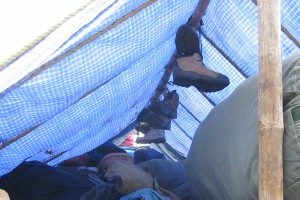 I tried not to worry, but I did glance at my watch several times that day. After breakfast, we bused back down the mountain to look for more birds. Our bus was the familiar twenty-person vehicle similar to ones used on other birding trips, comfortable and dependable. We stopped along the way at promising birding sites, shedding layers of clothing as we dropped in elevation and as the day warmed. Before long, the heavy-duty support truck passed us with all the equipment packed and tied down under a blue plastic tarp in the back. Three men sat atop the load in their down jackets and flip flops, singing and waving. Their boots, tied together by the laces, swung from the side of the truck. The men only used boots for the colder places, and preferred to wear flip-flops, or running shoes.
I tried not to worry, but I did glance at my watch several times that day. After breakfast, we bused back down the mountain to look for more birds. Our bus was the familiar twenty-person vehicle similar to ones used on other birding trips, comfortable and dependable. We stopped along the way at promising birding sites, shedding layers of clothing as we dropped in elevation and as the day warmed. Before long, the heavy-duty support truck passed us with all the equipment packed and tied down under a blue plastic tarp in the back. Three men sat atop the load in their down jackets and flip flops, singing and waving. Their boots, tied together by the laces, swung from the side of the truck. The men only used boots for the colder places, and preferred to wear flip-flops, or running shoes.
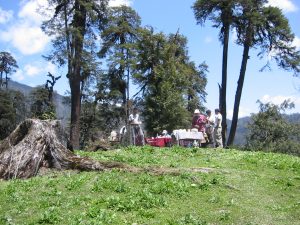
At noon, we rounded a corner to discover our checkered tablecloth again at another scenic spot on a little hill. Climbing off the bus into pleasantly warm air, we trudged up the grassy slope to our table. Halfway there, an arbor of branches decorated with freshly cut rhododendrons greeted us. The men had prepared our food in the morning and transported it from the breakfast site in insulated containers, so they had plenty of time to refresh the flowers on the arbor. The men grinned at our surprise and pleasure as we passed under their creation. After a “birdy” morning full of new birds, we tucked into a meal of steamed rice with a sumptuous chicken stew and crisp vegetables.
At our birding stops, we met friendly people walking to or from town, or to their plots of land. They wore a mix of well-worn Western clothes, and functional, traditional wraps. Many wore rubber boots for working in wet fields. Everyone smiled, and a few who spoke English chatted with us. Pema chatted with them as we walked along the river, or in the marshes. They seemed to take us in stride. We weren’t the first birding group to pass that way.
Living Standards in Bhutan
When we reached the Paro Valley where we had spent our first night, we encountered our first large farms. Because so much of Bhutan is steep and rocky, farmers work every inch of suitable soil. Only two percent of the land in Bhutan is arable, most of which is located in the foothills below 1,000 feet on the 12-mile strip of land in the south that abuts India. There are also bigger farms in the flat valleys of the larger rivers in the middle mountain area at an elevation of about 1,000 to 2,000 feet. Pema said farmers in the Paro River Valley are well off financially, able to build sturdy, larger houses near their fields. These farmers also own animals, and have access to markets for selling their goods.
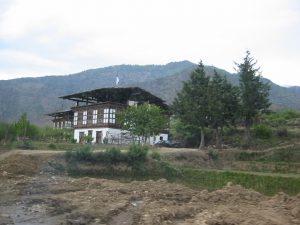
We saw tidy farms where the same families and their descendants had tended the land for generations. The well-constructed farmhouses were whitewashed and had solid wooden windows and doors. The ground level housed the animals, usually sheep, goats, a few cows, and an occasional horse. The family occupied the second level. The roof covered the third level, which was open to the weather. The family used the spacious third floor to thresh and store grains, and to wash and dry clothing. Children enjoyed playing games in the dry, protected area out of the mud and rain.
Later in our tour east of Thimphu, we traveled on a rural part of the main road where houses in the few towns were made of mud and wattle construction topped with tin roofs. Older houses had shingle roofs, each with an array of volleyball-sized rocks placed to secure the shingles in the high winds.
The International Fund for Agricultural Development estimates that more than thirty percent of the people in Bhutan are considered to be financially poor, and most of them live in rural areas. These are people who do not own land and have no other way to make a living, but survive on what they can grow on the decreasing supply of public land. Many are currently receiving help from international agencies to learn marketable skills. Access to healthcare, social services, education, and markets is a challenge, often requiring many hours of walking from the isolated villages.
We noticed phallic carvings jutting out from the corners of most roofs in the town of Paro, which we found delightful. Clearly, this was a cultural blip that we tourists did not understand. Pema had heard the questions often, and easily gave us the backstory.
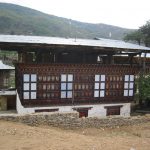
“There are phallic paintings inside and outside the houses,” Pema explained. “This custom originated when a dzong (a distinctive type of fortress found in Buddhist countries) was built near Punkha to honor Drukpa Kunley, a 15th century monk known as the “Mad Saint” who loved women and wine. The people believe that these phallic symbols drive away the evil eye and gossip.”
This information certainly tweaked our prudish view of such a public display, and lively comments circulated around the group. I love this type of cultural experience that challenges my own customs and beliefs.
Driving Over the Construction Site
We arrived at the bridge over the Paro River (Paro Chhu) well before 3:30 and I thought we could relax, knowing we would make it to Thimphu that day. I was wrong. The drive was not relaxing.
As we waited at the bridge, Pema gave us a preview of what we would face on the next leg of our trip along this “interesting” one-lane road. “To widen such a constricted road, the mountain must be blasted away,” Pema explained. “The rubble falls onto the existing road and some into the canyon. The workers must clear a path for traffic as quickly as possible, but it usually takes an hour or so before they can allow a pulse of traffic to pass. Then, traffic from the other end must come this way. You can see this is quite a project.”
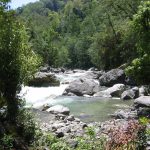 As he talked, we could see across the river to where huge construction machinery gnawed at an enormous mound of rubble, filling trucks that also had to use the road we were waiting to travel. Wow, that’s a mess! I thought.
As he talked, we could see across the river to where huge construction machinery gnawed at an enormous mound of rubble, filling trucks that also had to use the road we were waiting to travel. Wow, that’s a mess! I thought.
Obviously, this could be done, so I tried to relax and trust that we would make it to Thimphu to continue our tour. It had started with such lovely birds, mountain scenery, and unusual houses and people, I told myself. Surely, this would continue after only a brief delay.
We had more to learn about roads in Bhutan. While we waited, Pema gave us some background on Bhutan’s basic, but difficult road system. For many years, the only way to get to Thimphu from India was by trail from the Indian border. The trek of 130 miles took six days by foot, mule, or horse. In 1961, Third King Wangchuck directed the Bhutan government to develop and oversee the country’s First Five-Year Development Plan, which included road construction as a priority, along with building clinics, schools, and markets. India paid for most of the new construction and by 1962 Bhutan had completed the first 109 miles of paved road, which was described as a jeep trail, at best.
“Something you might find interesting is that the king also had to introduce the wheel to people accustomed to carrying bundles on their backs walking up and down the steep terrain,” noted Pema. “Wheels are only useful on roads, most of which had yet to be built in Bhutan, and once built, they often washed out. And that is still true today.”
We all gasped at that concept of “discovering the wheel in Bhutan.” By the mid 1970s, the Bhutanese had constructed just under a thousand miles of paved roads with thousands of manual laborers doing most of the work.
After about half an hour of waiting, traffic started moving and we crossed the bridge. In construction areas where the temporary road had been hastily created that day, our small bus crawled along in the line of vehicles that inched through, and over, piles and pits of dirt and rock. At one point, the truck in front of us tipped so far to the left side that I feared it would topple over, and possibly end up in the canyon. Thankfully, it didn’t. None of the vehicles in our line got stuck, but I wondered if the waiting laborers watching our passage might have to lend a hand if that did happen. At times, we were so close to the edge of the cliff, I had a clear view of the river far below. I tried to have faith that we would not topple over the side. Personally, I believe that if I don’t name something, it doesn’t exist. However, I noticed that the normally chatty birders on the bus were unusually quiet. We did glimpse a few birds down by the river. It was a small comfort to us because they were impossible to identify at such a distance.
The bus crept further east toward the heart of Bhutan, and we knew more fabulous birding awaited us once we got past this unbelievable stretch. I was so intent on each hair-raising moment that I forgot we would have to return along this same route. After an hour, the hastily built, temporary track seemed to improve. Finally, the road split and some traffic continued southwest to India. We followed the vehicles that turned left to cross another high bridge over the merged rivers, and headed northeast toward Thimphu, Bhutan’s capital. Fortunately, the road improved because the hillsides were less formidable, and the roadbed was packed and ready for paving.
About six miles from Thimphu, we encountered the future: a paved, two-lane expressway that we sped along into the city. That stretch of road from Paro to Thimphu was the only place in the whole country where we saw any heavy, road-construction machinery. Thousands of manual laborers built the remaining roads by hand.
Government Uniforms in the City
En route to Thimphu, we had more time to question Pema. One of my more pressing questions was, “Given the chilly temperatures at the mountain pass this morning, why are you wearing only a short wrapped robe and knee socks?”
I knew he must have a secret since this was his country. Pema explained that he wore his gho (pronounced go), the traditional men’s robe, because it was the required men’s dress in Thimphu and in all public places. “Our Fourth King Jigme Singye Wangchuck continued the policies of his father to modernize and democratize the country, but he saw the risk of losing what made Bhutan the country that he and all the citizens loved.”
Pema continued, “So in 1989, with the consent of his advisors, Fourth King Wangchuck reinforced the traditional dress and behavior code, called Driglam Namgha. These traditions had lost favor with many of the people in the past, but the king thought it was important to revive this tradition in order to preserve and strengthen the Bhutanese culture as the country evolved.” Pema motioned to his outfit. “Now, the Bhutan government requires all men who work in government offices or schools to wear the gho. In addition, men are required to wear this traditional Bhutanese garb on formal occasions and in the towns like Thimphu.”
Ever willing to question, I asked Pema how he felt about that.
“Oh, I like it even though it sometimes is a bit inconvenient,” Pema admitted. “This morning I had to wear long underwear under my gho to stay warm, and I rubbed my hands a lot to keep them warm. Some of the younger people were beginning to fall away from our traditions, and I didn’t like that. I’ll show you later how to behave at a dzong.”
A gho can be made of any material and the robe hangs to mid-calf. A wide woven sash called a kera, is wound around the waist and the fabric of the robe is pulled up over it so the hem hangs to knee length. This forms a pocket above the sash that is very handy for carrying things. We saw some men in Thimphu who carried so much stuff in the fold they looked pregnant.
Because all Bhutanese men had to wear their gho to official offices, and to monasteries as a sign of respect and an indication of their rank, we learned that a pair of quality, knee-high socks is a most appreciated gift for a Bhutanese man.
“What about the women?” I asked.
“The formal attire for women who work for the government includes a toego, a short, open jacket, a wonju, which is a blouse, and a kira, a floor-length, brightly colored panel of cloth that wraps around their waist.” Pema added, “You will not see many women in this attire in Thimphu since the men dominate the official government positions.”
Even the young people in Thimphu, who love to watch television and dress in modern clothes in their free time, are happy to don their traditional dress as required for school and work in spite of the delicious attraction to Western styles.
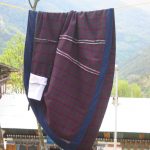
Later, when we traveled to remote towns far beyond city limits, fewer people wore the traditional garb. Many men wore well-used Western-style pants and jackets, and women wore lightweight, wrapped skirts and simple tops. Given the choice myself, if I were a man, I would take the pants over the gho the men wore. I imagined those winds rushing up underneath their robes would freeze everything.
Pema’s information about different dress codes for his country fascinated me, and it piqued my interest even further. I asked, “How did such a dress evolve in a country with weather as violent and cold as Bhutan’s?”
He did not know.
Later, when I returned home, I researched this question further. I learned that the wrap-type of clothing was the first used in every culture since weaving a flat piece of cloth developed early, and that trousers evolved only after people began to ride horses. When I learned this, I was chagrined at my cultural bias and disconnect from the obvious.
Buddhists & Animals
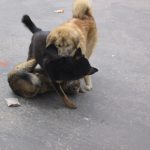 Buddhists revere all life and will go to great lengths to preserve the life of every living creature. Unfortunately, problems can arise. For example, Thimphu is overrun with feral dogs. Tourists feel threatened by the larger ones and complain about the nocturnal barking. Residents feed many of the dogs that settle into the neighborhood for the convenient meals. Several solutions have been tried; retirement homes and spay/neuter programs have proved inadequate against the dogs’ persistent breeding. Natural selection would limit the dog population, but as long as food is available, the dogs will breed to capacity.
Buddhists revere all life and will go to great lengths to preserve the life of every living creature. Unfortunately, problems can arise. For example, Thimphu is overrun with feral dogs. Tourists feel threatened by the larger ones and complain about the nocturnal barking. Residents feed many of the dogs that settle into the neighborhood for the convenient meals. Several solutions have been tried; retirement homes and spay/neuter programs have proved inadequate against the dogs’ persistent breeding. Natural selection would limit the dog population, but as long as food is available, the dogs will breed to capacity.
Even at our tent camp at 10,000 feet, a small pack of dogs wandered around our tents and erupted into a loud chorus of barking and howling that scared me out of a sound sleep. I had not expected to encounter dogs in such a remote place, but thought they might be hunting the reported rare mountain bears that roamed the area. But no such luck. They were farm dogs patrolling their territory, surprised at our intrusion. I must admit the dogs’ presence deflated my feeling of pleasant isolation that night.
Exploring Thimphu
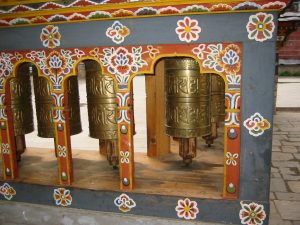
In the waning daylight, we set out to see a bit of Thimphu, the largest city in Bhutan, and the center for most of the political/administrative activities. Earlier, when we turned off the rough road from Paro and onto the new road, we had passed newer developments built to accommodate the recent influx of people. Government changes in 2007 had called for more administrators, and Thimphu’s population had expanded to about 66,000 residents. As of 2017, the population is about 104,000 people. Later, we learned that too few jobs are available to the rural people who migrate from their home valleys. As a result, Thimphu and the other towns are overwhelmed with the needs of a growing population.
In the city’s center, the buildings were primarily of traditional construction with lots of heavy wood beams and white painted stucco, accented with colorful decorations around the windows, doors, and under the eaves. Frequently, we saw
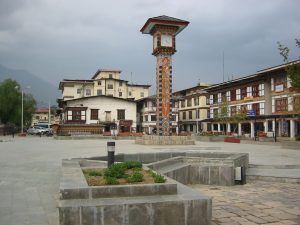
rosy-cheeked locals spinning Buddhist prayer wheels placed in open spaces throughout the town. Small roofs protected the prayer wheels, but not the people who used them in the rain.
We ducked into a few shops, looking for indigenous crafts, but we soon lost our energy. The altitude of 7,656 feet still took some acclimation. In addition, it had been a long day since our pre-dawn tea and snack, so we were all feeling sluggish. An early night was in order for all of us. The next day would be another one full of birds and more surprises.